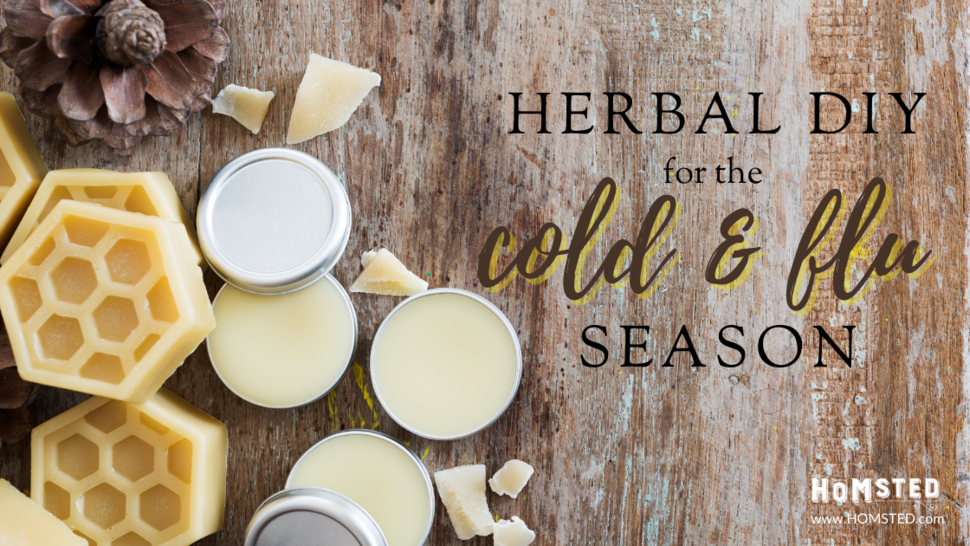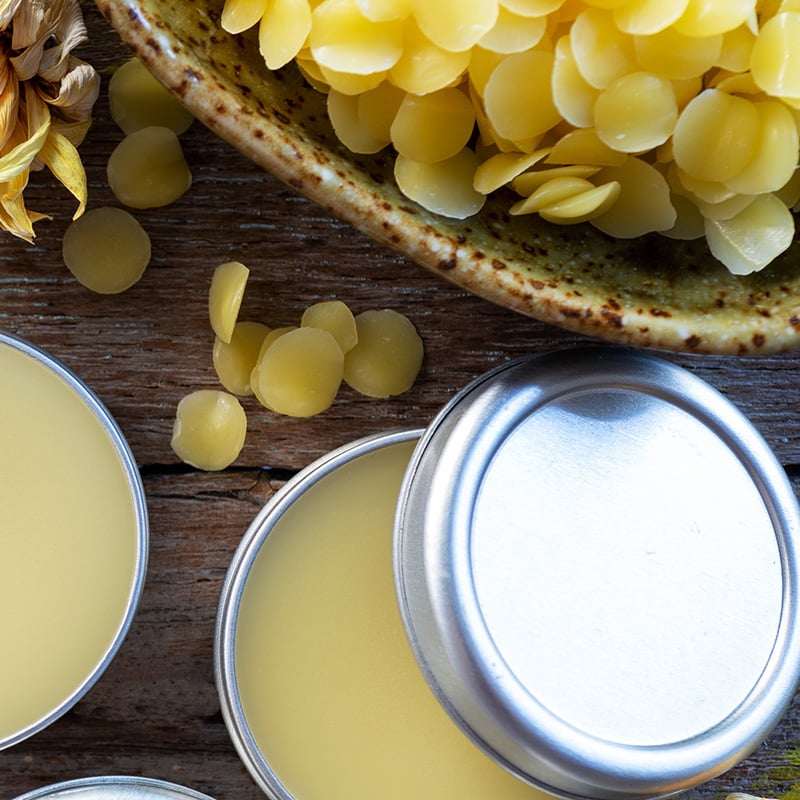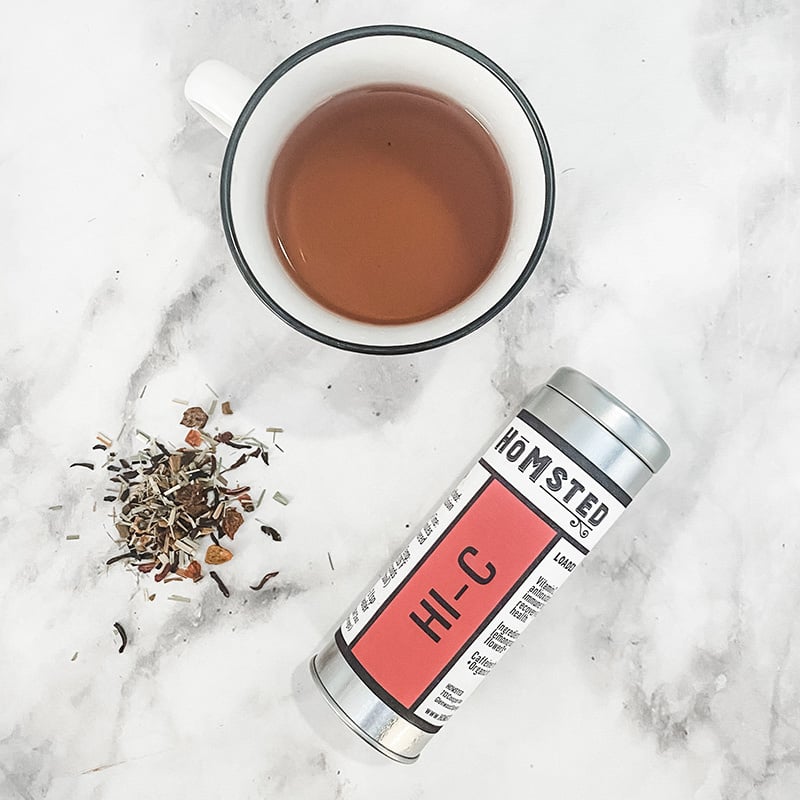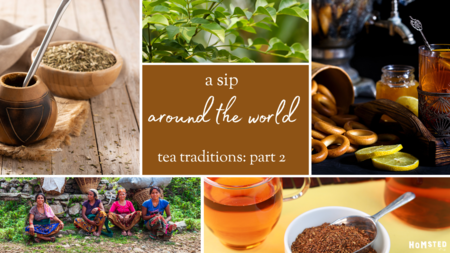Herbal DIY for the Cold & Flu Season

With the cold and flu season in full swing, we wanted to share with you a few herbal remedies that can aid in treating those more persistent symptoms.
These are remedies that you'll want to keep on hand in your home apothecary. They are simple and straightforward to make, so if you are just starting in making your own herbal remedies, these are a great place to start.
These also make great gifts to give, especially to those that are often exposed to cold and flu more often than most people. Or, you can include a little of each in a basket along with some homemade chicken soup for a sick neighbor or friend.
As with many cold and flu medicines, just know that these herbal remedies are created to help shorten the duration of infection and ease the symptoms that we might be experiencing: cough, stuffiness, or sore throat. There are no antibiotics that can “kill” a viral infection like for a bacterial infection, but these can certainly help with the severity of the symptoms when experiencing a viral infection.
So, with that being said, we hope you find this collection of recipes helpful and useful!
MENTHOL CHEST RUB – FOR ADULTS

This chest rub is one that will certainly aid in opening up your airways. Menthol is a particularly strong smell and is great for clearing out stuffiness. We make use of our essential oil blend, Breathe, which includes Eucalyptus, Peppermint, and Black Spruce, along with others. Since this particular recipe does call for menthol, we don’t recommend it for children under the age of 10.
It's a simple recipe to mix up and it also allows for you to make the consistency which best suits your liking.
Here’s what you’ll need:
8 oz. of carrier oil
1/2 – 1 tsp menthol crystals
3/4 oz – 1 oz beeswax
20 drops eucalyptus globulus essential oil
20 drops breathe essential oil
Here’s how to make it:
Depending on the texture you want, measure out the beeswax. Keep in mind that less wax will yield more of an ointment viscosity, while the whole ounce of wax will create a more solid, lip balm-like consistency.
Heat the carrier oil and beeswax in a double boiler just until the beeswax melts. Remove from heat. Be sure not to overheat the beeswax. Overheating destroys many of the self-preserving qualities of beeswax and it will also cause you to overheat and volatilize the menthol and essential oils that you’ll be adding in the next steps.
Add menthol crystals (1/2 tsp for a gentle balm or 1 tsp for a stronger remedy) and essential oils, stir until dissolved, and quickly pour into jars. Immediately place lids loosely over the jars so the oils don't escape, but allow to cool completely before sealing caps onto the containers.
Note: The menthol crystals are super-concentrated and may be irritating when inhaled, so always use them in a well-ventilated area or wear a mask if needed.
MENTHOL-FREE CHEST RUB – FOR CHILDREN
Because the menthol crystals can be too strong or irritating for children, we recommend a milder, yet still effective chest rub for your little one.
Here’s what you’ll need:
8 oz. carrier oil
1/2 oz – 1 oz beeswax
10 drops Eucalyptus raditata
10 drops ravensara
5 drops niaouli
Here’s how to make it:
Depending on the texture you want, measure out the beeswax. Keep in mind that less wax will yield more of an ointment viscosity, while the whole ounce of wax will create a more solid, lip balm-like consistency.
Heat the carrier oil and beeswax in a double boiler until the beeswax melts. Remove from heat and let cool slightly.
Add essential oils and pour into jars. Immediately place lids loosely over the jars so the oils don't escape, but allow to cool completely before sealing caps onto the containers.
HERBAL HONEY
Now, there are many reasons to have herbal honey on hand during the cold and flu season. But most importantly, the herbs added to the honey give you extra support. In its simplest form, the honey can easily be added to warm tea as a way of gaining extra benefits from the infused honey and can help soothe any sore throat issues.
Here’s what you’ll need:
raw, local honey of choice
herbs of choice (fresh or dry)
A few herbal combinations to consider:
- Chamomile, lavender, and/or lemon balm for calming frayed nerves.
- Fennel, chamomile, peppermint, and/or ginger to soothe tummy troubles.
- Garlic, ginger, thyme and cinnamon for cold prevention, treatment, and respiratory issues
As a general rule, we recommend tightly packing a jar half way with herbs then filling in the remainder of the jar with honey.
Here’s how to make it:
There are two ways to make herbal honey.
Method 1. Pack jars half way with choice of with herb, then cover with honey. Allow herbal honey to sit at least one week or for up to six weeks for a stronger effect and flavor. Turning jars every couple of days is optional but will facilitate the infusion process.
Method 2: Pour the desired quantity of honey into a double boiler. Add herbs. Gently heat for 10-20 minutes, stirring frequently. Pour mixture into jars. Keep in mind, heating honey does destroy many of the beneficial qualities, so if time allows, consider method 1.
For both methods, the herb may be left in to make a stronger medicine as well as for a very pretty effect.
STEAM INHALATION MIX
There are a few ways in which you can help decongest during a cold or flu. At night, the chest rub is a good alternative while you are sleeping to help keep airways open. But during the day, we recommend inhaling over steaming water.
With this method, you can use steam inhalation two or three times a day. The steam helps to open the airways and thins out the mucus so it’s easier to remove. The herbs you add to the water can additionally aid this process.
Here are the herbs we recommend: eucalyptus and any additional member of the mint family herbs; this includes mint, spearmint, and even rosemary!
Thyme is also a great addition to this kit. It's both antiseptic and antiviral and has been used for ages for coughs and colds.
Pine needles also work wonders. You can look for any type of pine needle that grows near you, like cypress, fir, black spruce, or just plain pine needles.
You can also use relaxing herbs, like chamomile and lavender because, hey, we could also use a little extra help getting a relaxing, restful sleep with a cold or flu.
Or, rather than making your own, you can also take some of our Breathe Herbal Tea, and add that to your steaming water. It’s already blended for you, so it makes the process that much easier for you!
If you’d rather make your own, here is our recommendation for an herbal steam inhalation mix.
Here’s what you can use:
1 ½ oz eucalyptus leaves
½ oz rosemary
½ oz thyme
1 oz chamomile, lavender, or even catnip
20 drops of Breathe essential oil (optional)
¼ cup of Dendritic salt (optional; use only if you use essential oils)
How to make you inhalation kit:
If using the essential oil, mix with salt until thoroughly combined. Then, add in the other dried herbs.
Store in an airtight, glass container. Keep container out of sunlight.
How to safely use the herbs/oils during inhalation:
First, safety precautions: You’ll want to have a heat-proof bowl (in other words, no metal!) that you pour the boiling water into. Make sure the water isn’t too hot for you as the steam can burn! And you’ll want to make sure the bowl sits on a sturdy, flat surface so the risk of spilling is minimized.
Add up to 2 tablespoons of your herb/oil mixture to the water. Lean over your bowl, making sure not to touch the bowl, and cover your head with a towel. Keep your eyes closed while holding your face 8 to 12 inches above the bowl. Try to inhale the steam deeply. Inhale for up to 5 minutes and then remove the towel to breathe in some fresh air. Renew with hot water as needed.
Repeat a few times a day for up to 15 minutes each time.
As always, stop if you feel dizzy or the steam is too hot. We also recommend this type of steam inhalation for adults only. For children, the best method is to stand in a steaming shower.
STAYING HYDRATED WITH TEA

We all know that during a cold or flu, it is very important to stay hydrated. And nothing helps more than herbal tea. Try to avoid those teas with caffeine as they can dehydrate you if you drink too much.
We have a few options already prepared for you and we highly recommend our Shield Herbal Tea blend, Breathe Herbal Tea Blend and Hi-C Herbal Tea blend.
Our Shield Herbal Tea blend is our best tea blend to support the immune system. Used for centuries, these herbs help stimulate and support immune function so you can get better quicker. This blend contains herbs such as Astragalus, Elderberry and Echinacea root. You would make this tea as a decoction.
The Breathe Herbal Tea blend contains herbs such as eucalyptus, peppermint, thyme, among others that are incredibly helpful in opening airways and helping mucous move along.
Our Hi-C Herbal Tea blend is one of our most popular teas, not only because it’s our best-tasting herbal tea, but also because it’s packed with Vitamin C, which is critical for proper immune function and helping speed up your recovery time.
Want to make your own Herbal Tea blend? Then here is a recipe to mix of your own.
Nourishing Winter Blend Tea
2 oz Nettle leaf
2 oz Oatstraw
1/2 oz Ginger
1/2 oz Cinnamon
1/4 oz clove
This blend is rich in vitamins and minerals which your body needs to stay healthy and immune boosting herbs to keep you strong.
Click here to read about how to make an herbal tea infusion.
Once you’ve got your herbal tea blended and ready to go, why not add a touch of herbal honey? Just remember, for the maximum benefit from honey, add to your tea once it has cooled to drinking temperature. Heating honey destroys many of the enzymes that make it such an amazing product.
MOISTURIZING LIP BALM
This Lip Balm is simple to make and can be used for both men and women. With cold and flu season upon us, you’ll be thankful to get some of this incredibly moisturizing lip balm. It seems that even with the softest of tissues, our lips and noses seem to get a bit chapped with all the nose blowing!
Choose a scent that best suits your needs. Think about peppermint when you are a bit stuffy or vanilla for everyday use.
Here’s what you’ll need:
1 tsp Beeswax
1 tsp Cocoa Butter
2 tsp Shea Butter
1 tsp Jojoba Oil
1 tsp Sweet Almond Oil
15 drops essential oil (again, peppermint or vanilla are great additions)
10 drops vitamin E
Here’s how you’ll make it:
Melt beeswax, cocoa butter, shea butter, and oils together in a double boiler. Once all ingredients are melted, remove from heat.
When the mixture has cooled down a bit, add essential oil and the vitamin E into the mixture. Stir and pour into lip balm containers. Allow to solidify.
Alternatively, you can reuse clean cosmetic containers or small metal tins for storage. This should be hard enough to use in lip balm tubes as well.
WARMING ELDERBERRY IMMUNITY SYRUP

Now, we’ve saved the best for last. If you’ve done any reading about natural, herbal remedies that help during the cold and flu season, you’ve almost certainly run across elderberry syrup. Elderberries are incredibly potent and helpful in boosting your immune system to keep you healthy and to help lessen the symptoms. They also contain compounds that interfere with viral replication; giving your body some much needed assistance when battling a viral infection.
As a general rule, you can make the simple elderberry syrup as detailed below. But, if you want an option, or if you are short on time, you can purchase our Elderberry Syrup Kit, which already has everything measured out for you. You just choose with or without honey.
Here’s what you’ll need:
1 cup of dried elderberries
½ cup rosehips (I prefer cut and sifted, but whole also works just fine)
¼ cinnamon chips or 5-10 cinnamon sticks
pinch of cloves
few pinches of dried ginger root
vanilla bean
Here’s how to make it:
Bring 4 cups of water to a boil. Once boiling, add all ingredients.
Cover pot, and reduce heat to simmer. Simmer for at least 20 minutes.
Once simmered, strain out herbs. A cheesecloth or fine sieve will work.
Pour liquid back into the pot and continue to simmer with lid off until the liquid amount is reduced to 2 cups.
Once the liquid is reduced to 2 cups, you can add 1-2 cups of honey.
Optional: You can also add an extra kick with a splash of brandy! This can help increase the ‘shelf life’ of your syrup.
Gently warm until all optional ingredients are integrated if desired.
Once cooled, bottle and refrigerate. Use within 2 months, or within 2 weeks of reopening; whichever comes first. Finished amount: approx. 32 ounces.
As with any herbal treatment, we always recommend you see professional advice before using herbal medicine. And, as always, if your symptoms are persistent, please consult your physician.
If you try any of these recipes, be sure to let us know in the comments below! Or even better, tag us @homsted_lifestyle to show us!!




